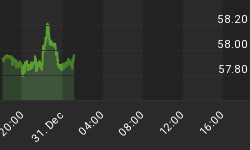John Hussman (Hussman Funds) wrote in his February 3, 2014, Weekly Market Comment: "The latest data from the NYSE shows equity margin debt at a new all-time high. Relative to GDP, the current 2.6% level was eclipsed only once - at the March 2000 market peak."
The ratio of margin debt is usually - at least, often - calculated in comparison to the market value of stocks. Later in his Comment, Hussman explains his choice: "We use GDP here because margin debt to GDP has a much higher correlation with actual subsequent market returns than say, margin debt/market capitalization (which destroys information by muting the indicator exactly at points when prices are extremely elevated or depressed)."
The March 2000 peak was an example of our so-called policymakers clamming up. Their duty is exactly the opposite. Quoting from Greenspan's Bubbles: The Age of Ignorance at the Federal Reserve, by William A. Fleckenstein and Frederick Sheehan: "On February 17, 2000, the subject of margin debt came up when the chairman testified before the House Banking Committee, just as it had three weeks earlier, when Greenspan had appeared before the same committee of the Senate. Despite having been thoroughly interrogated on the subject by an obviously concerned Senator Schumer on January 26, Greenspan reiterated the view that he shared in his previous testimony, that raising margin requirements would have no effect on stock prices.
"In response to the question from Senator Schumer during the January Senate appearance, Greenspan had staked out his views on the subject, stating that raising margin requirements would discriminate against the small investor and, furthermore, studies had 'suggested the level of stock prices has nothing to do with margin requirements.'
The Fleckenstein & Sheehan response: "I have no idea what studies he was referring to...." We then wrote of a couple of possibilities, far-fetched, instead of writing that Greenspan had lied. After the crash, Greenspan gave the most noxious speech of his life at Jackson Hole, Wyoming, on August 30, 2002. Blameless as always, the worm tacked on a footnote: "Some have asserted that the Federal Reserve can deflate a stock-price bubble - rather painlessly - by boosting margin requirements. The evidence suggests otherwise. First, the amount of margin debt is small, having never amounted to more than about 1-3/4 percent of the market value of equity..."
First, the amount does not matter, since the problem lies with the level of the ratio and rate of advance. Hussman writes: "[T]he main usefulness of this measure isn't for any fixed correlation with subsequent returns - numerous valuation measures do much better - but for its extremes. This is particularly true when margin debt advances rapidly over a span of several quarters relative to prices, GDP and other measures." Hussman's chart shows advances similar in 2000, 2007, and in 2013 and 2014. (Total margin debt had risen 45% between October 1999 and February 2000.)
Although "numerous valuation measures do much better," Hussman notes: "Prior spikes in margin debt/GDP in June 1968, December 1972, August 1987, March 2000, and October 2007 were followed by a bear market losses of at least one-third of market value shortly thereafter."
As to valuation measures: "In the context of the most extreme bullish sentiment in decades, and reliable valuation metrics about double their historical norms prior to the late-1990's bubble (price/revenue, market cap/GDP, Tobin's Q, properly normalized price/forward operating earnings, price to cyclically-adjusted earnings), we view present market conditions as dangerously speculative."
Most everyone knows we are at the edge, in their gut, if not their mind. Experts are paid to say otherwise. Again, the closer the cliff, those who are paid to keep investors in the game, and at necessarily greater feats of leverage, will make ever more reassuring claims.
It is my sense the Federal Reserve is losing its credibility with the public. Woe betide us the day it loses credit-ability. As with anxiety about stocks, this may be latent. It will pour forth when leverage retreats. Newly inducted Federal Reserve Chairman Janet Yellen offered testimony before the Senate Banking Committee for the first time yesterday, February 11, 2014. She was full of reassurances: "The economic recovery gained greater traction in the second half of last year." Asset prices are not at "worrisome levels." In questions and answers, she said something like "stocks are savings." (If anyone has the actual quote, please let me know.) This is to be expected. To forestall the complete loss of Fed creditability, more direct contradictions to the truth will be asserted.
In September 1996, bespattering his fellow FOMC comrades with an excess of machismo (should such be possible), the "greatest central banker who ever lived" - Alan Greenspan, in the words of Alan Blinder - claimed: "I recognize that there is a stock market bubble problem at this point. . . . We do have the possibility of raising major concerns by increasing margin requirements. I guarantee that if you want to get rid of the bubble, whatever it is, that will do it."
From John Hussman's February 3, 2014, Weekly Comment:
"Just a note - I'll be speaking at the Wine Country Conference in Sonoma, CA on May 1st & 2nd, 2014, along with Mike "Mish" Shedlock, David Stockman, Stephanie Pomboy, Steen Jakobsen, Chris Martenson, Mebane Faber, Jim Bruce and others. This year's conference will benefit high-impact programming for individuals on the autism spectrum and their families, primarily local efforts through the Autism Society of America. As many of you know, my 19-year old son JP has autism, so the cause is very close to my heart. Last year's conference benefited the Les Turner ALS Foundation. It's a great event in a beautiful location. Hope to see you there. For more information, please visit www.winecountryconference.com. Thanks - John"
Frederick Sheehan writes a blog at www.aucontrarian.com

















